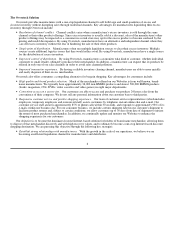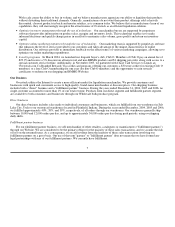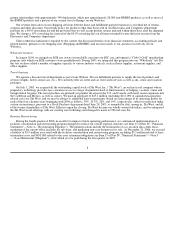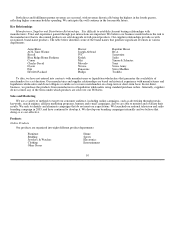Overstock.com 2006 Annual Report Download - page 17
Download and view the complete annual report
Please find page 17 of the 2006 Overstock.com annual report below. You can navigate through the pages in the report by either clicking on the pages listed below, or by using the keyword search tool below to find specific information within the annual report.
could harm our business. The trading price of our securities could decline due to any of these risks and uncertainties, and investors
may lose part or all of their investment.
Risks Relating to Overstock
We have a history of significant losses. If we do not achieve profitability, our financial condition and our stock price could
suffer.
We have a history of losses and we may continue to incur operating and net losses for the foreseeable future. We incurred net
losses attributable to common shares of $25.1 million and $101.9 million for the years ended December 31, 2005 and 2006,
respectively. As of December 31, 2005 and 2006, our accumulated deficit was $96.8 million and $198.7 million, respectively. We will
need to generate significant revenues to achieve profitability, and we may not be able to do so. Even if we do achieve profitability, we
may not be able to sustain or increase profitability on a quarterly or annual basis in the future. If our revenues grow more slowly than
we anticipate, or if our operating expenses exceed our expectations, our financial results would be harmed.
We will continue to incur significant operating expenses and capital expenditures as we:
• enhance our distribution and order fulfillment capabilities;
• further improve our order processing systems and capabilities;
• develop enhanced technologies and features;
• expand our customer service capabilities to better serve our customers' needs;
• expand or modify our product offerings;
• rent or terminate warehouse and office space;
• increase our general and administrative functions to support our operations; and
• maintain or increase our sales, branding and marketing activities, including maintaining existing or entering into new online
marketing arrangements, and continuing or increasing our national television and radio branding campaigns.
Because we will incur many of these expenses before we receive any revenues from our efforts, our losses may be greater than
the losses we would incur if we developed our business more slowly. Further, we base our expenses in large part on our operating
plans and future revenue projections. Many of our expenses are fixed in the short term, and we may not be able to quickly reduce
spending if our revenues are lower than we project. Therefore, any significant shortfall in revenues would likely harm our business,
prospects, operating results and financial condition. In addition, we may find that these efforts are more expensive than we currently
anticipate which would further increase our losses. Also, the timing of these expenses may contribute to fluctuations in our quarterly
operating results.
If we fail to accurately forecast our expenses and revenues, our business, operating results and financial condition may suffer
and the price of our securities may decline.
Our limited operating history and the rapidly evolving nature of our industry make forecasting operating results difficult. We
have recently completed several large, complex and expensive infrastructure upgrades in order to increase our ability to handle larger
volumes of sales and to develop or increase our ability to perform a variety of analytical procedures relating to our business, and we
are continuing the work to upgrade and further expand these and other components of our infrastructure. We have experienced
difficulties with the implementation of various aspects to the upgrades of our infrastructure, and have incurred increased expenses as a
result of these difficulties. As a result of these expenditures, our
16
























